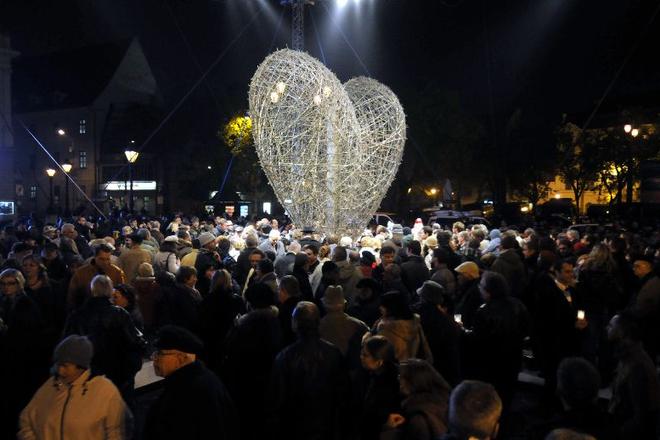HVIEZDOSLAVOVO Square in Bratislava has a new memorial called The Heart of Europe. Unveiled on November 17 for the 20th anniversary of the Velvet Revolution, it is a large-scale replica of an original work done by artist Daniel Brunovský 20 years ago from barbed wire torn from the border fence that separated Czechoslovakia from Austria.
“The November revolt from 20 years ago was not just a revolt against the Communist regime. It is crucial to realise that it was an extraordinary revolt against the immorality that filled the previous social system,” said the mayor of the capital, Andrej Ďurkovský, to the audience of about a thousand people who attended the ceremony. He added that it was the rejection of this immorality that brought tens of thousands of people into the streets of Bratislava and many others elsewhere with a strong, decades-long forgotten longing for a dignified life.
“This barbed wire was originally straight and was fastened at the poles on our borders. Such barbed wire ignited the hearts of our parents, grandparents, and also ours, so that we removed it from our borders,” said Ján Čarnogurský who was imprisoned in Bratislava exactly 20 years ago. He added that today the barbed wire is in the form of a heart and it will now remain in this form and will ignite the hearts of people so that they do good deeds.
The first heart made from barbed wire by Brunovský was displayed in December 1989 at Devín, the site where the barbed wire started to be symbolically cut from the fence that divided Czechoslovakia from the countries of western Europe.
“The first heart was improvised, made very hastily. But we were driven by our emotions. We made it right on the spot; we were not even prepared technologically. I remember how terribly cold it was outside,” Brunovský recalled for the SITA newswire. At that time, thousands of Slovaks were taking part in the event Ahoj, Európa (Hello, Europe) and they marched along both embankments of the Danube from Bratislava to Devín and then to Hainburg, Austria.
In 2002, the original heart was washed away by floods. Brunovský says the new heart, completed in three weeks, is a commemoration. “It is a new work of art, it is a memorial. It is made in a more perfect and more thorough way. It has to survive, and I hope that it will survive.”



 The Heart of Europe (source: ČTK)
The Heart of Europe (source: ČTK)